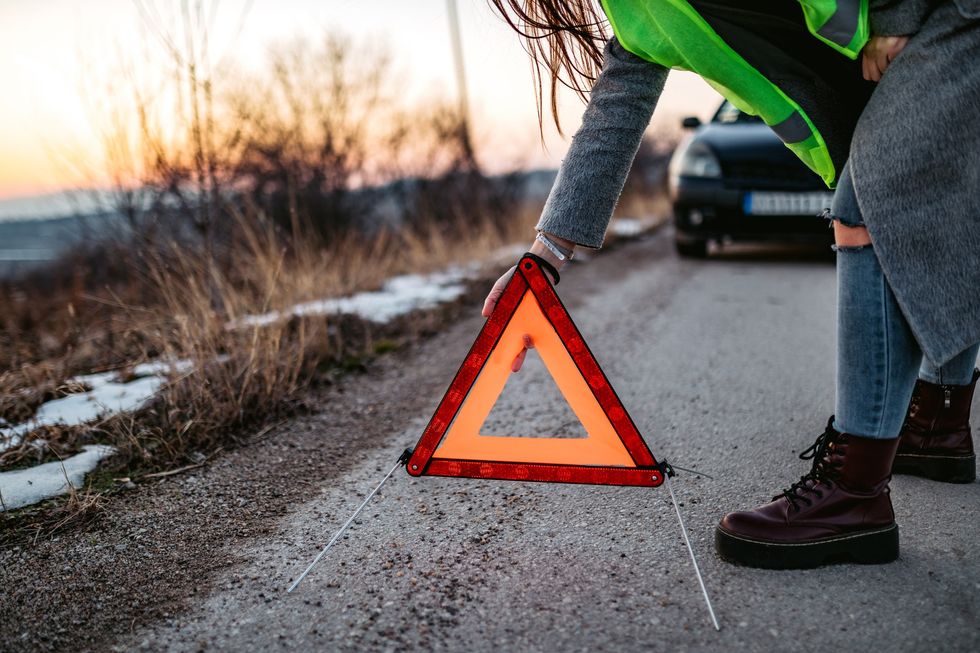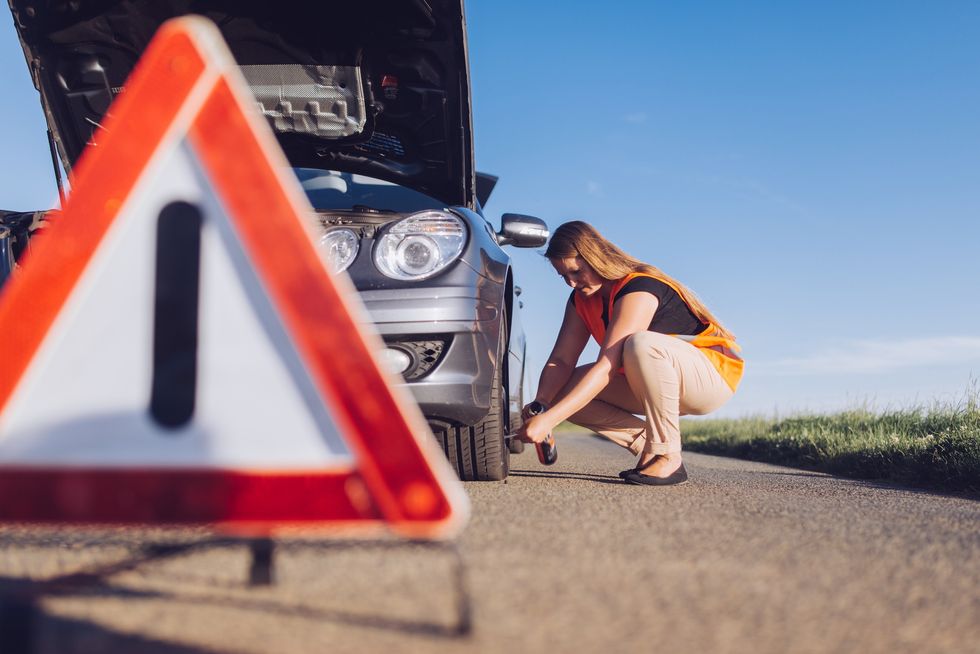Hemma Visavadia
Guest Reporter
A shocking new report has revealed concerning gaps in driver knowledge about what to do during vehicle breakdowns, which could potentially put lives at risk on UK roads.
The research found that 13 per cent of drivers would place a warning triangle directly next to their vehicle on a motorway, despite this being extremely dangerous.
A further 41 per cent revealed they would position a triangle 45 metres behind their vehicle, which would involve stepping into live traffic, which safety experts have strongly advised against.
The survey highlighted significant differences in safety behaviours across various road types, with drivers showing varying levels of awareness depending on whether they break down on motorways, dual carriageways, country roads or in car parks.
Do you have a story you'd like to share? Get in touch by emailing [email protected]

The AA warned that knowledge gaps can have potentially "life-threatening consequences" if incorrect actions are taken during breakdown situations.
On regular motorways, 92 per cent of drivers said they would activate their hazard lights during a breakdown, compared to just 85 per cent on smart motorways.
This gap is particularly concerning given the increased dangers posed by live traffic lanes on smart motorways, which lack hard shoulders for drivers to stop safely on. Similarly, 92 per cent of drivers said they would call for assistance on regular motorways compared to 82 per cent on smart motorways, despite reporting a breakdown being critical in both scenarios.
The survey revealed that 88 per cent of drivers would use a hard shoulder on regular motorways, but only 47 per cent would attempt similar actions on smart motorways.
When it comes to personal safety, 83 per cent would exit their vehicle on regular motorways, compared to 76 per cent on smart motorways.
The AA advised drivers to pull over as far left as possible, turn their wheels left, activate hazard lights, and wait behind a barrier upstream of traffic when safe to exit the vehicle.
On dual carriageways, almost all UK drivers (93 per cent) would call their breakdown provider as their priority when experiencing a breakdown.
Hazard lights were considered crucial for warning other drivers of a stationary vehicle, with 89 per cent of respondents recognising this importance.
However, while three-quarters of drivers understood the importance of pulling over quickly when breaking down on a dual carriageway, many motorists are potentially unaware of the urgency of removing their vehicles from live traffic lanes.
Meanwhile, only 56 per cent of drivers said they would pull up on the hard shoulder if possible during a dual carriageway breakdown, according to the AA.
On country roads, 95 per cent of drivers would call their breakdown provider, the highest percentage across all road types. This highlighted a heightened sense of caution in rural areas where help might be further away.
The survey found that nine in 10 drivers would activate their hazard warning lights on country roads, slightly higher than the 85 per cent who would do so in urban areas.
LATEST DEVELOPMENTS:

When looking at warning triangles, 38 per cent of drivers said they would use one if they had broken down on a country road. However, nearly half of these respondents (18 per cent) would place it directly next to their car, contrary to safety guidelines.
Find Out More...
The research found that 13 per cent of drivers would place a warning triangle directly next to their vehicle on a motorway, despite this being extremely dangerous.
A further 41 per cent revealed they would position a triangle 45 metres behind their vehicle, which would involve stepping into live traffic, which safety experts have strongly advised against.
The survey highlighted significant differences in safety behaviours across various road types, with drivers showing varying levels of awareness depending on whether they break down on motorways, dual carriageways, country roads or in car parks.
Do you have a story you'd like to share? Get in touch by emailing [email protected]

The AA warned that knowledge gaps can have potentially "life-threatening consequences" if incorrect actions are taken during breakdown situations.
On regular motorways, 92 per cent of drivers said they would activate their hazard lights during a breakdown, compared to just 85 per cent on smart motorways.
This gap is particularly concerning given the increased dangers posed by live traffic lanes on smart motorways, which lack hard shoulders for drivers to stop safely on. Similarly, 92 per cent of drivers said they would call for assistance on regular motorways compared to 82 per cent on smart motorways, despite reporting a breakdown being critical in both scenarios.
The survey revealed that 88 per cent of drivers would use a hard shoulder on regular motorways, but only 47 per cent would attempt similar actions on smart motorways.
When it comes to personal safety, 83 per cent would exit their vehicle on regular motorways, compared to 76 per cent on smart motorways.
The AA advised drivers to pull over as far left as possible, turn their wheels left, activate hazard lights, and wait behind a barrier upstream of traffic when safe to exit the vehicle.
On dual carriageways, almost all UK drivers (93 per cent) would call their breakdown provider as their priority when experiencing a breakdown.
Hazard lights were considered crucial for warning other drivers of a stationary vehicle, with 89 per cent of respondents recognising this importance.
However, while three-quarters of drivers understood the importance of pulling over quickly when breaking down on a dual carriageway, many motorists are potentially unaware of the urgency of removing their vehicles from live traffic lanes.
Meanwhile, only 56 per cent of drivers said they would pull up on the hard shoulder if possible during a dual carriageway breakdown, according to the AA.
On country roads, 95 per cent of drivers would call their breakdown provider, the highest percentage across all road types. This highlighted a heightened sense of caution in rural areas where help might be further away.
The survey found that nine in 10 drivers would activate their hazard warning lights on country roads, slightly higher than the 85 per cent who would do so in urban areas.
LATEST DEVELOPMENTS:
- Labour to confirm phase out of petrol and diesel cars by 2030 this Spring - 'Environmental necessity'
- Electric car switch at risk and UK factories could close without 'substantive' changes - 'Worrying times'
- Drivers could be hit with a £1,000 fine and penalty points for breaking major Highway Code rule

When looking at warning triangles, 38 per cent of drivers said they would use one if they had broken down on a country road. However, nearly half of these respondents (18 per cent) would place it directly next to their car, contrary to safety guidelines.
Find Out More...
